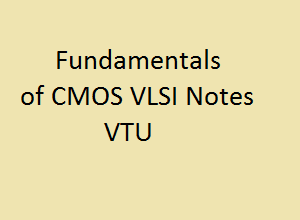Here you can download the Fundamentals of CMOS VLSI VTU Notes PDF – CMOS VLSI VTU of as per VTU Syllabus. Below we have list all the links as per the modules.
Fundamentals of CMOS VLSI VTU Notes PDF – CMOS VLSI VTU of Total Units
Please find the download links of Fundamentals of Fundamentals of CMOS VLSI VTU Notes PDF – CMOS VLSI VTU Notes VTU are listed below:

Link : Complete Notes
PART-A
Link: Part A Notes
Unit-1:
Basic MOS Technology Integrated circuits era, enhancement and depletion mode MOS transistors. nMOS fabrication. CMOS fabrication, Thermal aspects of processing, BiCMOS technology, production of E-beam masks. 3 Hours MOS transistor theory Introduction, MOS device design equations.
Link: Unit 1 Notes
Unit-2:
Circuit Design Processes MOS layers, stick diagrams, Design rules, and layout- lambda-based design and other rules. Examples, layout diagrams, symbolic diagram, tutorial exercises. Basic physical design of simple logic gates.
Link: Unit 2 Notes
Unit 3:
CMOS Logic Structures CMOS complementary logic, BiCMOS logic, Pseudo-nMOS logic, Dynamic CMOS logic, clocked CMOS logic, Pass transistor logic, CMOS domino logic cascaded voltage switch logic (CVSL).
Link: Unit 3 Notes
Unit-4:
Basic circuit concepts Sheet resistance, area capacitances, capacitances calculations. The delay unit, inverter delays, driving capacitive loads, propagation delays, wiring capacitance Scaling of MOS circuits Scaling models and factors, limits on scaling, limits due to current density and noise.
Link: Unit 4 Notes
PART-B
Link : Part B Notes
Unit-5:
CMOS subsystem design Architectural issues, switch logic, gate logic, design examples-combinational logic, clocked circuits. Other system considerations. 3 Hours Clocking strategies
Link: Unit 5 Notes
Unit-6:
CMOS subsystem design processes General considerations, process illustration, ALU subsystem, adders, multipliers.
Link: Unit 6 Notes
Unit-7:
Memory registers and clock Timing considerations, memory elements, memory cell arrays
Link: Unit 7 Notes.
Unit-8:
Testability Performance parameters, layout issues I/O pads, real estate, system delays, ground rules for design, test, and testability.
